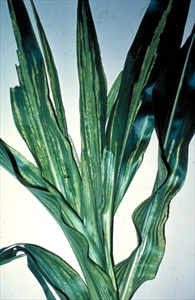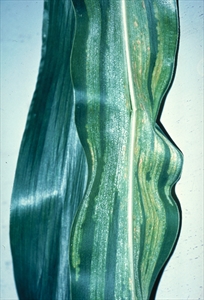Sugarcane downy mildew
Pacific Pests, Pathogens, Weeds & Pesticides - Online edition
Pacific Pests, Pathogens, Weeds & Pesticides
Maize (sugarcane) downy mildew (227)
Peronosclerospora sacchari
Asia, Africa (Nigeria only), Oceania. It is recorded from Fiji and Papua New Guinea.
Maize, sugarcane and sorghum.
The disease is caused by an oomycete or water mould, not a fungus. Although downy mildews look like fungi, they are related to algae.
At first, small, round, yellow spots on the leaves leading to pale yellow to white stripes as the oomycete grows in the leaves (Photos 1&2). Several stripes may be present on each leaf, often extending the entire length. A white downy fungal growth develops on both sides of the leaves, and on the husks. The downy growth develops at night, especially when dew is present.
This was previously an important disease of maize, more than it was on sugarcane, although previously in Fiji the disease caused major losses in sugarcane before resistant varieties were available. Maize may become stunted, with poorly developed ears, although it is usually of minor importance because of resistant hybrids.
Look for the yellow to white stripes, and the white downy growth that occurs on both sides of the leaves.
CULTURAL CONTROL
Before planting:
- Choose hybrid varieties with known resistance to maize downy mildew; this is the most important way of managing the disease.
- Do not plant maize close to sugarcane in case of cross-contamination.
During growth:
- Remove infected plants as soon as they are seen; take them out of the planting and burn them.
- Do not interplant maize and sugarcane.
After harvest:
- Collect the remains of the crop and destroy by burning, burying, or remove and use as livestock feed.
RESISTANT VARIETIES
There are resistant hybrid varieties to this disease; check those available from retailers in your area.
CHEMICAL CONTROL
Chemical control should not be necessary for the management of this disease, and its use is unlikely to bring economic returns. However, if fungicides were needed, use products containing metalaxyl and mancozeb.
____________________
When using a pesticide (even a biopesticide), always wear protective clothing and follow the instructions on the product label, such as dosage, timing of application, and pre-harvest interval. Recommendations will vary with the crop and system of cultivation. Expert advice on the most appropriate pesticide to use should always be sought from local agricultural authorities.
AUTHOR Grahame Jackson
Information CABI (2008) Peronosclerospora sacchari (sugarcane downy mildew). Crop Protection Compendium. (https://www.cabi.org/cpc/datasheet/44642). Photos 1&2 Kohler F, et al. (1997) Diseases of cultivated crops in Pacific Island countries. South Pacific Commission. Pirie Printers Pty Limited, Canberra, Australia.
Produced with support from the Australian Centre for International Agricultural Research under project PC/2010/090: Strengthening integrated crop management research in the Pacific Islands in support of sustainable intensification of high-value crop production, implemented by the University of Queensland and the Secretariat of the Pacific Community.





